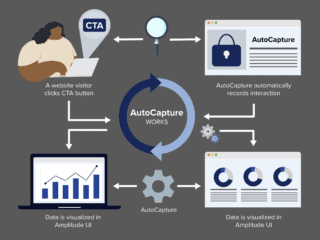Data-driven transformation is the future of business and there is no question about it. Data-driven transformation means understanding your customer better than they understand themselves and delivering meaningful moments to them by leveraging data insights.
This type of transformation requires a fundamental change in the way companies think about their customers and an even more fundamental change in how they design their products or services for those customers. Digital transformation starts with using data to identify opportunities, measure progress against goals, and monitor performance over time.
It also includes empowering teams with tools that enable them to act on this information quickly so that it can be used for decision-making at all levels of an organization. This can help align your various marketing teams and data silos and empower your teams to act faster on valuable data insights.
Using such tools to empower people at every level of a company creates highly engaged employees who feel connected to their work and can therefore provide more value to customers by being equipped to anticipate what they want next. This leads companies down a path toward delivering meaningful moments through personal or even predictive analytics, making data-driven transformation an essential part of a business across different teams and levels of the organization.
Undertaking such a massive organizational transformation is not easy and requires deep expertise within data science, digital analytics, digital media planning, and execution. It also requires strong business leadership to execute effectively across a wide spectrum of disciplines and teams.
While not an easy project to execute, with strong expertise and exceptional planning, you can map out a path to data-driven marketing maturity. But first, it’s critical to understand which of the four stages your business currently sits in: nascent, emerging, connected, or multi-moment. This will inform what your next steps should look like to work toward digital transformation.
Let’s discuss the four stages of data-driven marketing maturity and how they can help you take your digital transformation to the next level.
Stage 1: Nascent
What is the nascent stage?
In this stage, campaign execution relies largely on external data and direct purchases, with little connection to sales. Most organizations in this phase are just getting started with data-driven marketing. They may have begun collecting data internally but haven’t yet integrated it into their overall strategy. In addition, many marketers at this stage don’t know which types of data will best serve their needs. As a result, they often collect too much data and end up drowning in it.
To move forward from the nascent stage, we recommend focusing on building a solid foundation. Rather than trying to do everything at once, identify three areas of opportunity and build slowly. These could be customer acquisition, customer retention, or cross-channel attribution data. Once you’ve identified those opportunities, think about whether there are specific metrics available for each and begin gathering that data, whether it comes from internal systems or third-party vendors.
Once you’ve collected all the necessary data, make sure you understand its limitations. Ask yourself the following questions:
- What does the data tell us?
- How accurate is it?
- Is it timely enough?
- Are there other factors influencing results?
- Can I use this data in combination with my gut to make sure I’m going down the right path as our digital maturity evolves?
If you find yourself struggling to get answers to these questions, consider hiring someone with experience in data analysis to guide you through a comprehensive process tailored to your organization’s needs.
Stage 2 – Emerging
What is the emerging stage?
Organizations in the emerging state use internal data and data from indirect purchase channels, like social media and search engine optimization, but without much integration between different parts of the business.They may limit their use of owned data in automated buying to single-channel optimization and testing. Marketers in this stage begin to leverage real-time data from multiple channels to make decisions faster and may start connecting internal and external data sources directly to sales.
As you continue to gather data, you should see improvements in key performance indicators, but some KPIs likely aren’t improving as quickly as others. That’s because certain outcomes require additional effort to measure accurately. To solve this problem, look beyond traditional KPI measurement methods and explore alternative ways to track progress.
Here are two examples for alternate tracking methods during the emerging stage of digital transformation:
1) Use behavioral insights to identify trends. Behavioral insights allow you to observe changes in human activity over time. By analyzing historical data, you can gain valuable insights into how consumers behave and respond to various stimuli. From here, you can determine which actions lead to positive outcomes and which ones cause negative reactions.
2) Measure ROI through conversion rate improvement. Conversion rates are typically measured based on the number of people who complete a valued action. But what happens after they convert? Do they become customers and actually buy your product/service? This is where measuring ROI becomes tricky.
For example, let’s say 100 people signed up for an email list but only 10 became paying customers. In this case, the conversion rate would appear low. However, if 90% of those 10 paid customers converted again within 30 days, then the true conversion rate would be much higher than reported.
In both cases, tracking conversions requires extra work. Fortunately, there are several tools designed specifically for this purpose. One such tool is Google Analytics 360 (GA360). With this solution, you can easily segment users based on their behavior and create custom dimensions tailored to meet your needs. This kind of platform can offer powerful features like multi-channel attribution or data-driven attribution that can inform your bidding strategies within Google Ads, Microsoft Ads (formerly Bing Ads), and Search Ads 360 (SA360).
Stage 3 – Connected
What does it mean to be connected?
Connected organizations dive deeper into both internal and external data sources, including CRM, email, and web analytics. With some degree of automation, these marketers have access to real-time insight from multiple touchpoints.
Marketers can also create a connected experience through the use of specific tools within the Google Marketing Platform (GMP), such as SA360, Display & Video 360 (DV360), and Campaign Manager 360 (CM360). If you’re using SA360 to move up the maturity curve you must move through a number of steps to reach the connected stage of this platform.
When advertisers first adopt SA360, they are usually in the nascent phase, using it to report across the organization with campaigns that use manual bidding and last-click attribution. As they mature and move towards the emerging stage, they begin to enable bid strategies for select campaigns, test auction-time bidding, and deploy a sitewide tagging implementation to be able to measure the right KPIs. As they gain more data and become more sophisticated, organizations move toward the connected stage, where all search campaigns use a bid strategy, and they implement data-driven attribution (DDA) to inform the bidding strategies used to target various audiences. Reaching the connected stage also means having your first-party audiences from Google Analytics integrated into SA360. Most advertisers opt into an active budget plan to manage their budget effectively over the course of a month.
The connected phase is where you, as an advertiser, move to a more algorithmic approach, where automated bid strategies and machine learning will now take over real-time decisioning based on large data sets. The connected stage also means that marketers have access to cross-device conversions that can be used for retargeting campaigns across all devices, like smartphones and tablets. This provides advertisers with better visibility into consumer behavior, allowing them to create more personalized campaigns.
The goal is not just understanding your customers or prospects better but also providing a connected experience throughout their entire journey with your brand. To use the full power of the GMP for customer experiences, you need to use other platforms like DV360 to connect your display and video advertising efforts to your search marketing campaign data within GA360 and CM360.
The integration with GA360 allows you to perform holistic analysis across your advertising to uncover critical insights across your advertising stack. You can even create highly customized Google Analytics audiences to push into DV360 for remarketing and campaign optimization.
What are the benefits of linking DV360 and CM360 with GA360?
To be able to track the impact of digital marketing campaigns on customer behavior and acquisition, it’s important to connect data from multiple sources. When you link these three platforms together, you get a complete view of how consumers interact with your brand across multiple channels.
Connecting GA360, CM360, SA360, and DV360 provides marketers with a holistic view of their customers – both online and off – through what we call ‘connected marketing’. This solution helps you create a connected customer experience that integrates your ad spending across channels (Google, Bing, Facebook, and other programmatic media buys) to maximize performance. You can also gain valuable insights into consumer behavior using cross-device conversion tracking, which links users by assigning them an anonymous ID or cookie that follows them as they move between devices.
The connected phase allows advertisers to take advantage of more complex multi-touch attribution models, like DDA, that measure interactions between different channels/devices and assign credit, or value, accordingly. While there are several ways in which brands use DDA, the goal is to measure and track conversions as close to a customer’s purchase as possible. In turn, this provides marketers with a better understanding of their paid media performance as well as access to valuable insights into consumer behavior that can help inform future campaign strategies. Connecting data from multiple sources is beneficial because it enables you to create a robust view of your customer that can inform future campaign strategies.
For example, with cross device conversion tracking and bulk uploads (available within DV360 / CM360), brands can optimize ad spend across devices based on conversions rather than clicks – making measurement even more granular. By enabling marketers to understand the full value of their marketing spend, they are able to make better business decisions that will help optimize future campaign strategies while maximizing ROI for digital advertising spend.
Stage 4 – Multi-Moment
What does it mean to reach the multi-moment stage?
Marketers in this stage use dynamic execution optimized toward single-customer business outcomes across channels. The multi-channel environment is one where marketers should focus on removing friction to help customers accelerate through their journey faster. Optimizing single-customer business outcomes across channels requires execution that’s both nimble and measurable if it’s going to be successful.
This is an advanced stage where marketers leverage machine learning and artificial intelligence to create personalized experiences based on user behavior patterns. Marketers now have full visibility into consumer journeys and can deliver relevant content and offers at any point during the journey.
As consumers become increasingly aware of the power of big data, marketers must evolve beyond traditional one-way communication and start thinking about ways to deliver experiences that matter to each individual. Multi-moment communications allow marketers to engage with individuals in unique ways, providing tailored offers and promotions that resonate with specific audiences. These types of interactions will continue to grow in importance as we move forward towards a world where everyone has a voice.
The four stages above represent a journey of growth and learning. Each stage builds upon the previous ones and represents a new set of skills required to succeed in today’s market. While some may argue that any of the stages could be skipped entirely, I would strongly advise against skipping any of them. In fact, if you skip any of the stages, you’ll likely find yourself stuck somewhere between two adjacent stages. Working through each stage in succession will enable your organization to steadily build the capabilities, teams, and data connections required to effectively progress down the path toward digital transformation.


















